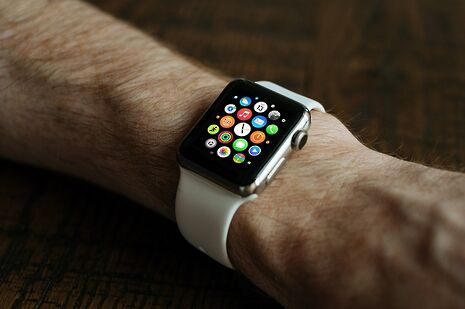Techwatch: Wearable tech – feelgood or to be feared?
In her new column, Charlotte Gifford asks whether we should embrace wearable technology, or fear it

Technology increasingly allows us to narcissistically document every aspect of our lives. Fitness-trackers like FitBit and Basis are taking this to a new extreme. With these devices, we can log how many hours we’ve slept, how many steps we’ve walked, as well as our blood pressure, stress level and skin temperature. It seems we may soon be monitoring our biological clock as obsessively as we check Facebook.
And wearables are only getting weirder. Bondara’s SexFit is the world’s first sexual fitness tracker, measuring the number of calories you burn, as well as thrusts per minute. You can then share this information on social media, for anyone who’s ever thought: “I want the world to know how peak my performance was there.” And then there’s Nixie, perhaps the most extreme selfie-taking invention yet. A wrist-mounted drone with a camera that leaps into the air to grab your action selfie won’t make you look like a pretentious twat at all.
But perhaps wearable technology’s most revolutionary development is in its potential to measure our moods.
I doubt I’m the only one who bought a mood ring as a child – but for anyone who’s never heard of them, mood rings are novelty gifts that claim to change colour depending on your mood. Mine was dark purple, and stayed dark purple whenever I wore it. This apparently meant that I was constantly feeling “mysterious”. Since I’d been expecting my ring to display a whole spectrum of colours throughout the day, this was a bit of a let-down, but otherwise I was pretty satisfied with its assessment.
Looking back, I now realise that ten-year-old me probably wasn’t all that dark and elusive, and it was only purple because it cost me about one quid. But jewellery and headgear that change colour to tell you your mood are becoming increasingly intelligent. For example, fashion company The Unseen have created a jewelled headdress that lights up as it detects changes in your brain activity. These gadgets come at a much heftier price than the old mood rings, but with good reason, as they use biometric sensors to measure your emotional state.
Companies claim these inventions will help people to increase their self-awareness. But many are taking this even further, contemplating the uses of being able to identify each other’s emotions from these new devices. Mindshare is one such company interested in using wearables as a marketing tool. The thinking behind this is that if advertisers knew when hearts were racing and when consumers were at their happiest, then in theory they could know when consumers would be most likely to buy, and what they’d be most interested in buying. Creepy, right? I mean, there’s a lot of things you think about buying that you don’t necessarily want popping up on TV all the time. Imagine being the dad of a teenage girl in a world of targeted advertising, and having to awkwardly work out for yourself why pregnancy tests keep coming up in the ad breaks.
Of course, people would have to opt in to having their data shared in the first place. But some argue that we’re more willing to do this than we realise. Scrolling through any form of social media serves as a reminder that we’re not exactly shy about posting emotional statuses, so would broadcasting the readings from our wearable tech really be so different?
If monitoring and uploading moods does catch on, we could be made constantly aware of how others are really feeling. You might be the one turned down at a job interview on the basis of having a higher stress response than your rivals. Arguments might be a lot more frequent. Dating agencies could utilise it pretty well, matching partners based on their temperaments – though, admittedly, that might kill romance stone dead.
Wearables are poised to take over as the latest technological trend. But we should be wary about what exactly we’re strapping onto our wrists. Privacy issues aside, I personally worry a bit about them malfunctioning. Monitoring bodily functions sounds like it could lead to a few unnecessary panic attacks of thinking “Is this the end?” every time your heart rate kicks up for no apparent reason. For the most part, a lot of us would find them hugely beneficial, but will get no closer to buying one until the price drops and wearables become, well, a little more wearable. As things stand, it’s unfortunately a little difficult to own a smartwatch without looking like a total knob.
 Comment / Anti-trans societies won’t make women safer14 November 2025
Comment / Anti-trans societies won’t make women safer14 November 2025 Features / Beyond the Pitt Club: The Cambridge secret societies you have never heard of16 November 2025
Features / Beyond the Pitt Club: The Cambridge secret societies you have never heard of16 November 2025 News / Controversial women’s society receives over £13,000 in donations14 November 2025
News / Controversial women’s society receives over £13,000 in donations14 November 2025 Fashion / You smell really boring 13 November 2025
Fashion / You smell really boring 13 November 2025 News / A matter of loaf and death17 November 2025
News / A matter of loaf and death17 November 2025








